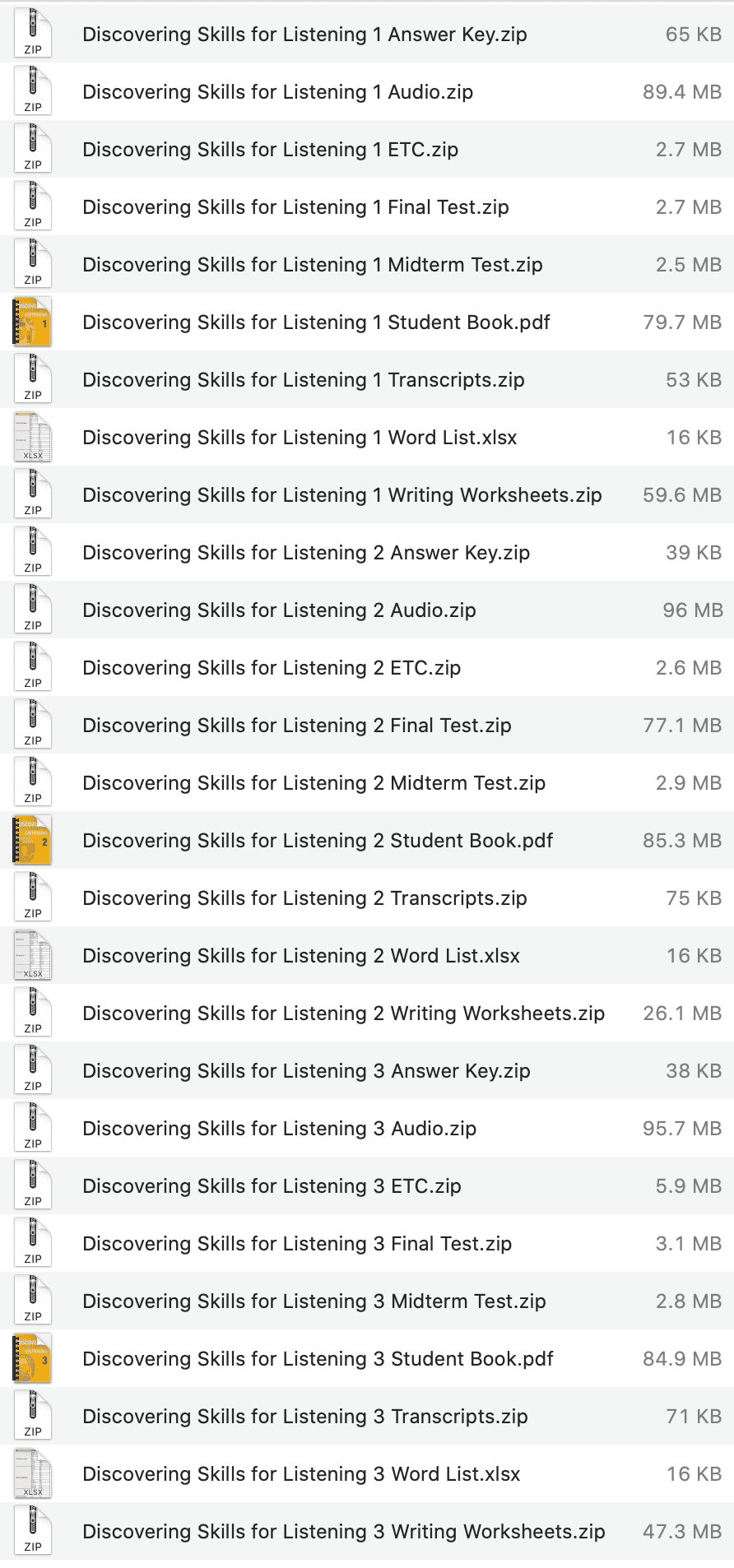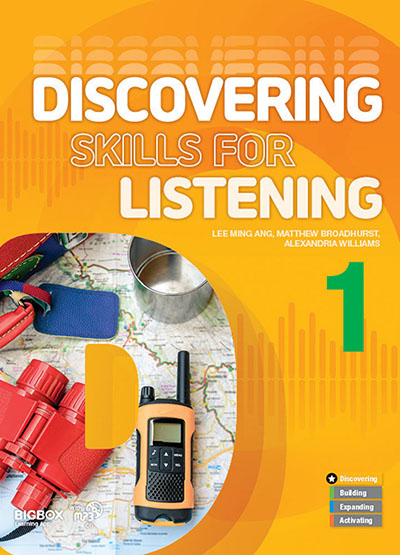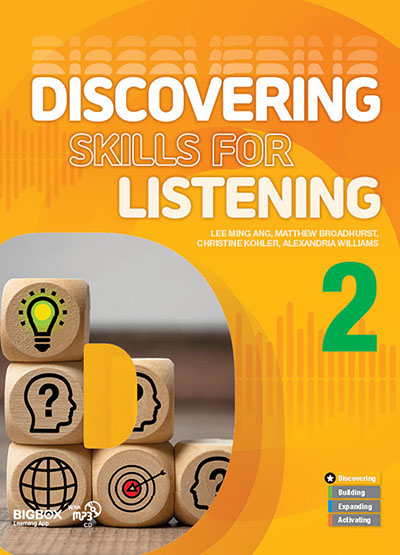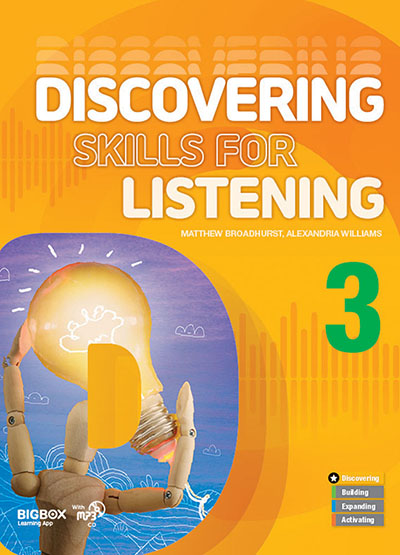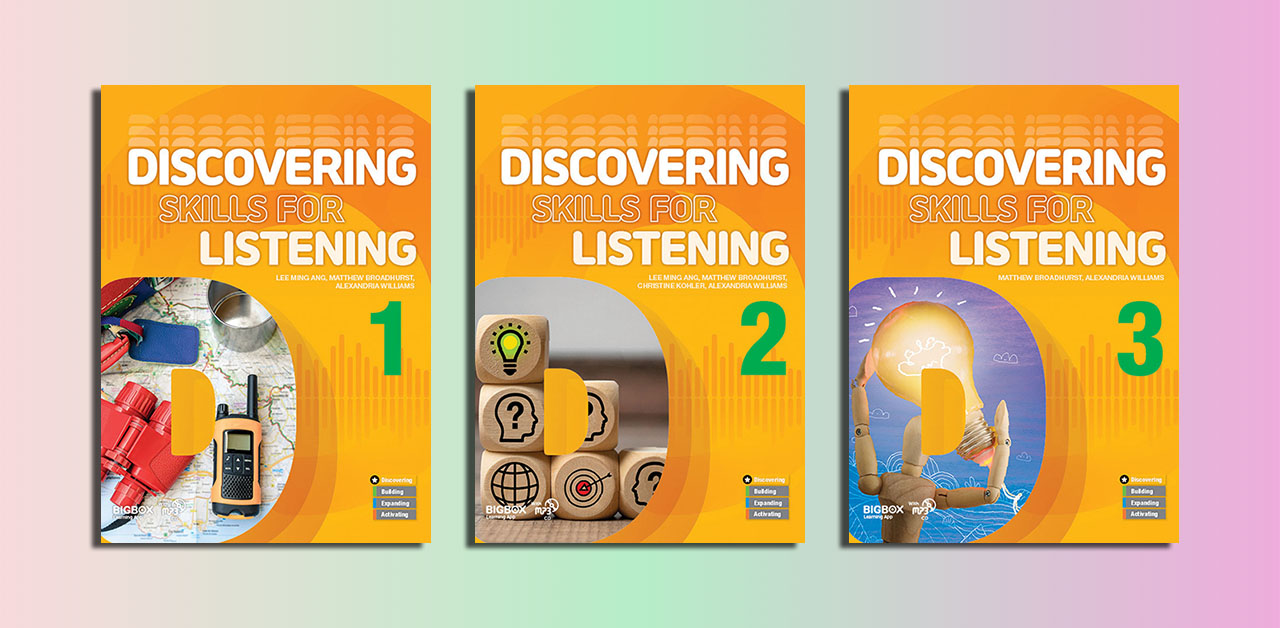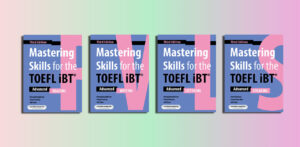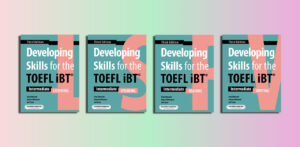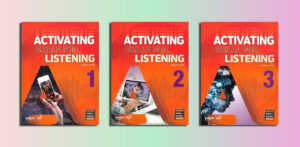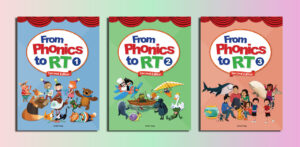Compass, Download, Online iTools
Download Discovering Skills for Listening Pdf Resources (Pre A1 / A1)
Discovering Skills for Listening (PDFs, Resources)
Level 1 (Pre A1)
Discovering Skills for Listening 1 Student’s Book.pdf – Sample: Click
Answer Key – Audio – ETC – Final Test – Midterm Test – Student Book – Transcripts – Word List – Writing Worksheets
Level 2 (Pre A1 – A1)
Discovering Skills for Listening 2 Student’s Book.pdf – Sample: Click
Answer Key – Audio – ETC – Final Test – Midterm Test – Student Book – Transcripts – Word List – Writing Worksheets
Level 3 (A1)
Discovering Skills for Listening 3 Student’s Book.pdf – Sample: Click
Answer Key – Audio – ETC – Final Test – Midterm Test – Student Book – Transcripts – Word List – Writing Worksheets
Discovering Skills for Listening (Pre A1 / A1): Click here
Building Skills for Listening (Pre A1 / A1): Click here
Expanding Skills for Listening (A1 / A2): Click here
Activating Skills for Listening (A2 / B1): Click here
Overview of the “Discovering Skills for Listening” by Compass Publishing
Contents
- 1 Overview of the “Discovering Skills for Listening” by Compass Publishing
- 2 Who is suitable for “Discovering Skills for Listening”?
- 3 The benefits of “Discovering Skills for Listening”
- 4 Effective learning strategies for “Discovering Skills for Listening”
- 5 Effective teaching strategies for “Discovering Skills for Listening”
| ✅ Coursebook: | Discovering Skills for Listening |
| ✅ Publisher: | Compass Publishing |
| ✅ Authors: | Lee Ming Ang, Matthew Broadhurst, Alexandria Williams |
| ✅ 7 Levels: | Pre-A1, A1 |
| ✅ Skills: | Listening |
| ✅ For: | Primary School |
| ✅ Publication year: | 2020 |
“Discovering Skills for Listening” is the inaugural course in Compass Publishing’s Skills for Listening series, designed specifically for young English language learners at CEFR Pre-A1 to A1 levels. As the foundational course, it sets the tone for the series by introducing essential listening skills, helping learners discover their English listening abilities, and preparing them for subsequent courses in the series. It builds a strong base for comprehension through engaging, age-appropriate content.
Target Audience and Levels:
Level 1 (Pre-A1): Aimed at high beginners, focusing on basic, high-frequency vocabulary and simple sentence structures to introduce core listening skills.
Level 2 (Pre-A1 to A1): Targets learners transitioning to low elementary proficiency, incorporating slightly more complex language while remaining accessible.
Level 3 (A1): Designed for elementary learners, this level strengthens listening skills with more developed dialogues, paving the way for CEFR A2 progression.
Key Features:
Content and Approach: The course presents listening skills through everyday topics relevant to young learners, using natural dialogues in real-world settings. It emphasizes high-frequency vocabulary and grammar expressions critical for building a solid English foundation.
Lesson Structure: Each unit follows a structured progression:
- Getting Started: Introduces key vocabulary and concepts.
- Warm-up Listening: Prepares learners with guided exercises.
- Real-Time Listening: Focuses on authentic, natural speech comprehension.
- Close-up Listening: Targets specific skills for deeper understanding.
- Checkpoint: Reinforces learning through review activities.
Supplementary Materials:
- A workbook with additional review and consolidation activities to solidify learning.
- Online resources, including audio playlists (e.g., on SoundCloud) for listening practice.
- A mobile app with QR code-accessible exercises for vocabulary and sentence building, catering to learners of varying abilities.
- A dictation book to enhance listening accuracy and attention to detail.
Educational Benefits:
- Establishes a strong foundation for the Skills for Listening series, fostering confidence in young learners.
- Uses controlled, age-appropriate language to ensure accessibility across Pre-A1 to A1 levels.
- Engages students with relatable topics and multimedia resources, supporting diverse learning styles.
- Prepares learners for progression through the series by building essential listening and language skills.
Unique Position: As the first course in the Skills for Listening series, “Discovering Skills for Listening” not only introduces critical listening skills but also sets a structured, engaging framework for the entire series, ensuring young learners are well-equipped to advance their English proficiency.
Discovering Skills for Listening 1 Student Book
Who is suitable for “Discovering Skills for Listening”?
- Young English Language Learners: Specifically designed for children or early teens learning English as a second or foreign language.
- CEFR Pre-A1 to A1 Proficiency Levels:
- Level 1 (Pre-A1): High beginners with minimal prior English exposure, needing basic listening and vocabulary skills.
- Level 2 (Pre-A1 to A1): Learners transitioning from high beginner to low elementary, ready for slightly more complex language.
- Level 3 (A1): Elementary learners aiming to strengthen listening skills and progress toward CEFR A2.
- Students Seeking Foundational Listening Skills: Ideal for those building a strong base in English listening through everyday topics and natural dialogues.
- Learners Needing Structured, Engaging Content: Suits students who benefit from controlled vocabulary, grammar, and multimedia resources (e.g., audio playlists, mobile app exercises, and dictation activities).
- Classroom or Self-Study Settings: Appropriate for guided learning with teachers or independent practice with workbook and online materials.
This course caters to young learners with varying abilities, providing accessible, age-appropriate content to foster confidence and competence in English listening.
Discovering Skills for Listening 2 Student Book
The benefits of “Discovering Skills for Listening”
The “Discovering Skills for Listening” course by Compass Publishing offers several benefits, particularly for young English language learners at CEFR Pre-A1 to A1 levels (Level 1: Pre-A1, Level 2: Pre-A1 to A1, Level 3: A1). Below is a concise overview of its key benefits:
- Builds a Strong Listening Foundation: As the introductory course in the Skills for Listening series, it equips young learners with essential listening skills, fostering confidence and preparing them for more advanced courses in the series.
- Engages with Relevant Content: Uses everyday topics and natural dialogues tailored to young learners’ lives, making listening practice relatable and motivating.
- Supports Gradual Skill Development: Structured lessons (Getting Started, Warm-up Listening, Real-Time Listening, Close-up Listening, Checkpoint) progressively build comprehension skills, aligning with Pre-A1 to A1 proficiency levels.
- Introduces High-Frequency Language: Focuses on accessible, high-frequency vocabulary and grammar, enabling learners to understand and use practical English in real-world contexts.
- Enhances Learning Through Multimedia: Offers diverse resources, including:
- Online audio playlists (e.g., SoundCloud) for authentic listening practice.
- A mobile app with QR code-accessible vocabulary and sentence-building exercises.
- A dictation book to improve listening accuracy and attention to detail.
- Reinforces Learning with Review: Includes a workbook with consolidation activities to solidify skills and ensure retention.
- Caters to Diverse Learning Needs: Controlled language and age-appropriate materials make it suitable for learners of varying abilities, supporting both classroom and self-study environments.
- Prepares for Progression: Builds a solid foundation that sets learners up for success in higher-level courses within the Skills for Listening series, advancing toward CEFR A2 and beyond.
These benefits make “Discovering Skills for Listening” an effective, engaging tool for young learners to develop their English listening abilities with confidence and clarity.
Discovering Skills for Listening 3 Student Book
Effective learning strategies for “Discovering Skills for Listening”
To maximize the benefits of “Discovering Skills for Listening” by Compass Publishing for young English language learners (CEFR Pre-A1 to A1), here are effective learning strategies tailored to the course’s structure and resources:
Follow the Structured Lesson Progression:
- Engage fully with the course’s sequential stages (Getting Started, Warm-up Listening, Real-Time Listening, Close-up Listening, Checkpoint). Start with vocabulary and context in Getting Started, then progress to Real-Time Listening for authentic exposure, and use Checkpoint to review. This builds a scaffolded approach to listening comprehension.
- Tip: Preview key vocabulary before each unit to reduce cognitive load during listening activities.
Active Listening with Repetition:
- Listen to the audio materials (available via platforms like SoundCloud) multiple times. First, listen for general understanding, then focus on specific details like vocabulary or grammar in subsequent listens.
- Tip: Pause and repeat short sections of dialogue to mimic pronunciation and improve retention.
Leverage the Mobile App:
- Use the mobile app’s QR code-accessible exercises to practice vocabulary and sentence-building outside class. These interactive tasks reinforce listening input with active recall.
- Tip: Set a daily goal (e.g., 5–10 minutes) to complete app-based exercises for consistent practice.
Use the Dictation Book Actively:
- Practice dictation exercises to sharpen listening accuracy. Write down what you hear, then check against the script to identify gaps in comprehension.
- Tip: Start with slower dictation and gradually move to natural-speed audio to build confidence.
Supplement with Workbook Activities:
- Complete workbook exercises after each unit to consolidate vocabulary, grammar, and listening skills. These activities reinforce what’s learned in the main course.
- Tip: Review incorrect answers to understand mistakes and revisit related audio clips.
Engage in Contextual Prediction:
- Before listening to dialogues, predict content based on unit themes or visuals. This activates prior knowledge and improves comprehension of real-world scenarios.
- Tip: Discuss predictions with peers or a teacher to enhance engagement and critical thinking.
Practice in Real-World Contexts:
- Apply listening skills to similar real-life situations, like watching English cartoons or listening to simple songs with themes like those in the course. This bridges classroom learning to practical use.
- Tip: Use subtitles initially, then remove them to challenge listening skills.
Collaborate and Discuss:
- In classroom settings, pair or group discussions after listening activities can reinforce understanding. Share what was heard and compare interpretations with peers.
- Tip: Role-play dialogues from the course to practice listening and speaking in tandem.
Set Incremental Goals:
- Break learning into manageable goals, such as mastering one unit’s vocabulary or understanding a dialogue without pausing. This suits the course’s progressive difficulty (Pre-A1 to A1).
- Tip: Track progress by noting how many listens it takes to fully understand a clip over time.
Review and Reflect Regularly:
- Revisit earlier units periodically to reinforce learning and build confidence. Reflect on improvements in understanding or areas needing focus.
- Tip: Keep a listening journal to note new words or phrases learned and review them weekly.
These strategies align with the course’s design, leveraging its structured lessons, multimedia resources, and focus on high-frequency language to help young learners effectively develop their English listening skills.
Effective teaching strategies for “Discovering Skills for Listening”
To effectively teach “Discovering Skills for Listening” by Compass Publishing to young English language learners (CEFR Pre-A1 to A1), educators can leverage the course’s structured design, multimedia resources, and focus on high-frequency vocabulary and everyday topics. Below are targeted teaching strategies to maximize student engagement and listening skill development, tailored to the course’s three levels (Level 1: Pre-A1, Level 2: Pre-A1 to A1, Level 3: A1).
Scaffold Lessons Using Course Structure:
- Follow the course’s built-in progression (Getting Started, Warm-up Listening, Real-Time Listening, Close-up Listening, Checkpoint) to guide students systematically. Start with Getting Started to pre-teach vocabulary and context, then progress to Real-Time Listening for authentic exposure, and conclude with Checkpoint for assessment.
- Tip: For Level 1 (Pre-A1), simplify explanations and use visuals; for Level 3 (A1), encourage more independent comprehension during Close-up Listening.
Incorporate Pre-Listening Activities:
- Activate prior knowledge by discussing unit themes or showing related images before playing audio. For example, ask students to predict dialogue content based on the topic (e.g., school, family).
- Tip: Use brainstorming or KWL charts (Know, Want to Know, Learned) to engage students, especially for Level 2 learners transitioning to A1.
Utilize Multimedia Resources Actively:
- Play audio from online platforms (e.g., SoundCloud playlists) in class, pausing to check comprehension or highlight key vocabulary. Assign app-based exercises (accessible via QR codes) for homework to reinforce vocabulary and sentence patterns.
- Tip: For Level 1, play audio at a slower pace initially; for Level 3, challenge students with natural-speed audio to build fluency.
Integrate Dictation for Precision:
- Use the dictation book to develop listening accuracy. Have students write down short dialogue excerpts, then compare with peers or the script. This works well for reinforcing phonemic awareness.
- Tip: For Level 1, use single sentences; for Level 3, include short paragraphs to match A1 proficiency.
Encourage Interactive Listening:
- During Real-Time Listening, pause audio to ask comprehension questions or have students summarize what they heard. Pair students for peer discussions after Close-up Listening to share interpretations.
- Tip: For Level 2, use guided questions to scaffold discussions; for Level 3, encourage open-ended responses to foster critical thinking.
Leverage Workbook for Consolidation:
- Assign workbook activities as in-class or homework tasks to reinforce listening skills and vocabulary. Review answers collectively to address common errors and clarify concepts.
- Tip: For Level 1, focus on matching or gap-fill exercises; for Level 3, include short-answer tasks to challenge comprehension.
Incorporate Role-Play and Contextual Practice:
- After listening activities, have students role-play dialogues from the course to connect listening to speaking. For example, reenact a shopping or classroom scenario from the unit.
- Tip: For Level 1, provide scripted prompts; for Level 3, encourage improvisation to build confidence.
Differentiate Instruction for Levels:
- Tailor activities to suit proficiency:
- Level 1 (Pre-A1): Use gestures, visuals, and repetition to support basic comprehension.
- Level 2 (Pre-A1 to A1): Introduce pair work and slightly longer audio clips to bridge skill levels.
- Level 3 (A1): Challenge students with inference-based questions (e.g., “Why did the speaker say that?”) to deepen understanding.
- Tip: Group students by ability for certain tasks to ensure appropriate challenge.
Promote Active Engagement with Games:
- Turn listening exercises into games, like “listening bingo” with key words from the audio or “spot the mistake” in dialogue summaries. This keeps young learners motivated.
- Tip: For Level 2, include team-based games to encourage collaboration; for Level 3, add competitive elements like timed comprehension quizzes.
Provide Regular Feedback and Review:
- Offer immediate feedback during Checkpoint activities to address listening gaps. Periodically revisit earlier units to reinforce retention and build confidence.
- Tip: Use a progress tracker (e.g., a chart for completed units) to motivate students, especially for Level 1 learners needing encouragement.
These strategies align with the course’s focus on structured learning, multimedia resources, and age-appropriate content, ensuring young learners develop listening skills effectively.

